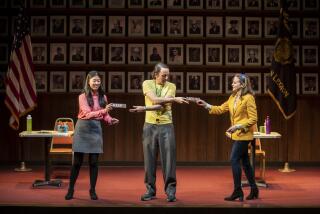Arts Poll: Less Participation, More Interest
- Share via
NEW YORK — A national poll on Americans and the Arts Tuesday showed videocassette recorder ownership up, leisure time continuing to drop and overall attendance at arts events down for the first time in 15 years.
But there was a bright side to the survey, the fifth conducted since 1973 by veteran pollster Louis Harris. He said it found public interest in the arts “staggeringly higher than anyone ever dared imagine.”
And, he said, the sharp rise in VCR ownership--now estimated at 55% of all households--portends a new arts market that could earn $2 billion annually in sales and rentals of taped performances of musical comedies, plays, operas, ballets and recent pop and classical concerts.
Harris spoke at a Lincoln Center press conference, where his poll, funded by Phillip Morris Cos., was released. It was based on a March-April phone survey last year of 1,051 people 18 and older.
The survey said that leisure time has shrunk at a “rapid rate” because of an increased number of families where both spouses work, what with the rise to 62% of the number of women now in today’s workplace from both desire and economic necessity.
Leisure time has dropped from 26.2 hours a week in 1973 to 16.2 hours last year, and “I suspect it’s going to get worse before it gets better,” Harris said.
His survey said the loss of leisure hours poses “a threat to all leisure-time enterprises,” including the arts, which suffered a overall 12% decline in attendance since 1984, when Harris’ last arts survey was made.
Although museum attendance rose by 24% and moviegoing 9%, significant drops were reported for attendance at live performances--particularly at pop and classical concerts. Each was down by 26% since 1984.
Other areas suffering attendance declines included opera and musical theater, down 38%; dance, down 14%, and theater, which declined 25% in attendance since 1984, according to the survey.
(In Los Angeles, 22.9 million people attended local arts events in 1984, according to a Los Angeles Area Chamber of Commerce survey. In that year, the report said the average person spent $18.25 including admission price. The chamber estimated that the overall economic impact of the arts here amounted to nearly $5.1 billion a year. Actual revenues of local arts organizations totaled $1.3 billion in 1984--a 169.1% increase from 1977 levels.)
Harris didn’t blame the declines on the growth of VCR ownership and the stay-at-home “couch potato” mentality that some observers say the new technology has brought to American life.
Rather, he said, the lack of available time is a major factor, as are the cost of tickets and lack of facilities and performances.
However, in discussing ticket prices, he said, “I would say time is much more important than money” to the public nowadays.
There is increased selectivity by the public, he said, and those in the arts need to find new ways to compete for the public’s time and do more market planning, including the price the public pays at the box office.
“It’s about time the arts woke up and became a lot more proficient in the marketing area than they’ve been,” Harris said.
Although the arts are going through a period of uncertainty and testing, he said, his latest survey shows they still remain a vital part of American life--with 16% more Americans reporting enjoying the arts than in 1973.
The poll also said that 90% of those questioned felt that “to see something performed live on stage is more meaningful and exciting than watching it on TV.”
It also reported an increase in the number of persons willing to pay higher taxes to support the arts, with 56% willing to be taxed an extra $25 annually for that purpose, compared to 50% in 1980.
Children and the arts also were a key part of the survey.
Ninety-one percent of those polled considered it important that school-age children be exposed to the arts, with 55% saying they didn’t think the children in their community had “enough opportunities to hear music and go to plays” and have other cultural experiences.
Eighty-four percent wanted their schools to finance full-credit courses in “writing poems or stories,” with 81% approving of children learning to play a musical instrument, draw, paint or sculpt.
Only 54% were in favor of credit for “art criticism,” with even fewer pollees, 47%, supporting credit for “aesthetics.”
Seventy-two percent said they were willing to pay more taxes “to make sure that children in school will be able to learn about the arts,” the survey said.
More to Read
The biggest entertainment stories
Get our big stories about Hollywood, film, television, music, arts, culture and more right in your inbox as soon as they publish.
You may occasionally receive promotional content from the Los Angeles Times.










